It's been eleven years in our world and sixty years in Magic: The Gathering's story, but we're finally returning to Dominaria. This is a plane laden with history and its consequences, a world that has seen more apocalypses than any one world should. The weight of that history is designed right into the cards.
This weekend, April 21 and 22, is the Dominaria prerelease: six packs, forty cards, and one tournament to embrace the myths and stories of this plane's past. Dominaria contains a few mechanics. Kicker returns, an ability that lets you power up a spell later in the game. Sagas are a type of enchantment that tell a story with three turns of effects. Legendary creatures flood the uncommon rarity, while new legendary sorceries offer extraordinary power if you control a legendary creature or planeswalker to help you cast them. Finally, a set about history cares about historic spells. A spell is historic if it's legendary, an artifact, or a Saga. If you want a deeper look at these mechanics, check out the Dominaria mechanics article.
All these mechanics can be found in every color, so Dominaria limited is going to be a bit more open-ended than most sets. Mechanics and subthemes are still focused in certain color pairs, however, and this article will examine the way each pair aims to play.
White/Blue: Historic Tempo
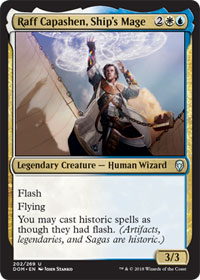
What better way to keep history alive than by slinging historic spells? In this set, white/blue is trying to play a tempo game by leveraging the power of the historic mechanic. This color pair loves artifacts, so that is the historic type that will be most important to this archetype. Many cards in these colors want you to be casting historic spells, so filling out your deck with cheaper artifacts gives you an easy way to trigger your abilities.
While artifacts are historic cards, don't forget that there are also some spells that specifically interact with artifacts. Sage of Lat-Nam is a perfect example of an artifact-matters card that slips into any blue historic deck. You can cast your artifact for a historic bonus then sacrifice it for a card later, building a little knowledge engine to propel you to victory.
Otherwise, white and blue are up to their same old tricks. Flying and flash will keep your opponent off balance, unable to efficiently defend themselves. Bounce spells and combat tricks give you a surprise edge. Stay ahead and watch your opponent struggle to catch up to your evasive attacks and tricky tactics.
Blue/Black: Historic Control
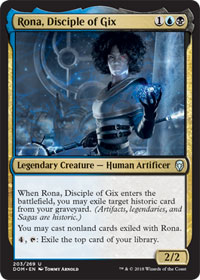
What better way to keep history alive than by extending a game until you win with raw card advantage? Carving out minor advantages over time is something both blue and black are familiar with, and Dominaria gives them a new mechanic to play around with. Of the three types of historic cards, Sagas are the one that play best in this color pair. Black has an extra Saga at uncommon, while blue has an extra Saga at rare.
The trick with Sagas is planning. They allow you to schedule effects for the next three turns, giving you a tactical advantage over the course of a longer game. Accruing value over time is what these kinds of control decks hinge on in limited. Combine the value of Sagas with the efficient removal in these colors and you'll find it easy to win with your late-game threats.
Removal, card advantage, and a cunning mind are the things blue/black loves. Your historic spells can help grind an opponent out of resources, allowing your graveyard interactions to provide the power to finish a match. Cabal Paladin and Lingering Phantom are two cards that fit especially well in this archetype. Both are at their best when played in a slower control deck that casts lots of historic spells.
Black/Red: Reckless Aggro
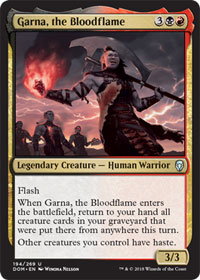
Garna is a Keldon warlord who wants Keld to get back to its bread and butter: abject violence. That's exactly what the black/red archetype in this set is all about. Historic? Don't need it. Kicker? No time for it. All we should be doing is casting creatures, turning them sideways, and slaying whomever gets in our way.
Aggro strategies rely on a critical mass of cheap creatures. You'll want lots of two- and three-drops, but also make sure they're cards that want to be attacking. Ghitu Chronicler may only cost two mana, but it won't be laying the beatdown as a 1/3. You want your two-drops to at least be 2/1s and ideally have aggressive mechanics like first strike, haste, or menace.
Black/red also wants to use your creatures as a resource. Saproling and Goblin tokens make your swarm larger, but they can also fuel powerful spells. Sacrificing them for a game-ending Goblin Barrage before that card disadvantage becomes an issue is the right play. Black is fine getting cards back from the graveyard, so you can mitigate the disadvantage of sacrificing your own army. Death is merely a detour on the road to conquest.
Red/Green: Kicker
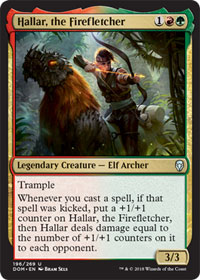
Kicker is one of my favorite mechanics in the game. You have a spell that does a thing or a creature with stats. But if you draw it later in the game, those cards can do so much more. Red/green champion this mechanic in Dominaria, but it's so much more than waiting until your spells get bigger.
I see a lot of players make suboptimal decisions with kicker. It's tempting to wait until your can get the bonus, but you really need to cast spells on-curve in limited. Untamed Kavu is the perfect example. You can cast it as a 2/2 with vigilance and trample for two mana or a 5/5 with vigilance and trample for five mana. In a vacuum, one card has better stats than the other. But in an actual game, having that 2/2 on turn two is going to win you more games than waiting and getting a 5/5 when you're too far behind.
Remember that this is an aggressive archetype. Cast your creatures on-curve and turn them sideways. What kicker does for red/green is grant flexibility in the late stages of the game. In sealed (which is slower than draft) and against control decks, being able to power up your spells will help close your games. If you're going to play with lots of kicker, I wouldn't run fewer than seventeen lands either. You can't take advantage of the mechanic's flexibility if you don't hit your land drops.
Green/White: Tokens
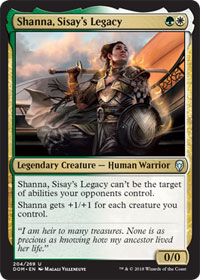
Who needs mechanics when you have numbers? Tokens are popular, and green/white highlights them as the go-wide strategy of Dominaria limited. The goal here is to flood the board with as many creatures as possible. With your army built up, even bad attacks won't be able to stop the damage your unblocked creatures can do.
In these kinds of strategies, your individual creatures can seem too small to rumble with your opponent's creatures. You'll want to find ways to even the score. Equipment is a solid option, as your stream of tokens will ensure you'll always have a creature to equip. Your army will force blocks often, so combat tricks can be extra deadly. Finally, cards like Charge and Wild Onslaught are optimized in this kind of strategy.
Token decks also have a second strategy: defense. If you can gum up the battlefield, you can find other ways to win the game while your opponent frustratingly fails to damage you. Evasion, such as trample and flying, helps your offensive creature win the game while you tokens protect you. Those expendable creatures can give you time to cast expensive, and thus powerful, spells (maybe with kicker) that can end the game swiftly. This is a flexible color pair, but make sure you focus on either offense or defense, not both.
White/Black: Legendary Creatures
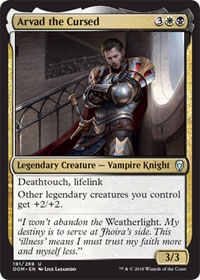
In the white/black archetype, your creatures are the stuff of legends. In order to support a legendary creature theme in limited, white and black each have three uncommon legends, two rare legends, and one mythic legend. There is also an extra multicolored legend at rare and a sixth legendary sorcery (which requires a legendary creature to cast) in these colors. Also note that On Serra's Wings can make any of your creatures legendary. Since every pack of Dominaria is guaranteed to have at least one legendary card, this archetype seems like it will be easier to build than you'd expect.
Because legendary creatures are powerful, they tend to be expensive to cast. This archetype skews more towards a midrange or control deck. White and black have good removal, so that helps. Control the board and your mighty heroes (and villains) will carry you to victory.
The main trick of this strategy is that there are no legendary cards at common. Instead, look towards historic bonuses or nab as many copies of Benalish Honor Guard as you can.
BONUS: White/black also has a minor Knight tribal subtheme. If you manage to get Aryel, Knight of Windgrace or History of Benalia, playing as many Knights as possible becomes a priority.
Blue/Red: Wizard Spells

Every set these days has at least one tribal theme in it. For Dominaria, that tribe is Wizards. Some of them even live on the coast! Classic wizard tropes include arcane research, magic wands, and casting spells. In Magic, this means slinging instants and sorceries. Having your tribal archetype also care about noncreature spells is a flavor win, but an odd couple, mechanically.
Here's how I would approach building a blue/red deck in this limited format. Start with the assumption that you're going to be playing a non-tribal spells deck. You'll want cheap creatures, fliers, plenty of burn spells, and some card draw. This formula is a proven strategy that works in limited.
Once you have the skeleton of a regular old spells deck, start adding the Wizard payoffs. This set is going to pull you in that direction naturally, especially if you have Wizard's Lightning or Wizard's Retort, which play into both the tribal and the spells themes.
BONUS: There might be a blue/red artifact deck in this set somewhere. I'm not sold on it being a thing yet, but Sage of Lat-Nam and Orcish Vandal both being at uncommon gives me build-around hopes.
Black/Green: Saproling Sacrifice
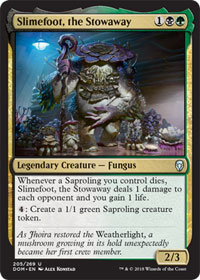
Sometimes sets have two tribal themes.
Saprolings, and the thallids that make them, are back! These spongey sprouts are a classic green race, but also show up on black cards now. This archetype combines two subthemes in two colors: sacrifice in black and tokens in green. Resource management is the name of the game here.
At common, the main sacrifice payoffs are Vicious Offering and Thallid Omnivore. Vicious Offering looks to be one of the best removal spells at common, and being able to easily kick it to kill most creatures is what this archetype does best. Thallid Omnivore has a threat-of-activation factor that makes it intimidating to block.
While black/green is founded on these sacrifice strategies, don't forget that Saprolings are 1/1s that can attack. Sporecrown Thallid and Wild Onslaught can win games out of nowhere if you amass enough tokens.
Red/White: Auras & Equipment
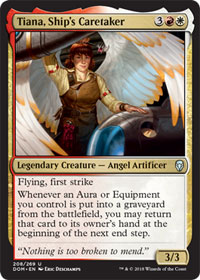
Auras have a tumultuous history in Magic. They are inherently card disadvantage; if the creature they're attached to dies, you lose the Aura too. If you make an Aura powerful enough to counter this disadvantage, it tends to be overpowered. Designing them is a tricky balance, especially in limited.
Dominaria attacks the Aura problem from a new angle: bundling them with Equipment. The historic theme already wants artifacts in the format, having your payoffs require either subtype means there is less pressure on Auras to be good, and enchantment interactions from Sagas can also play well with Auras. Just remember that you can't run too many Auras and Equipment in limited without risking not having creatures to attach them to.
Red/white wants to be aggressive and augment its creatures with Auras and Equipment. The payoffs here are strong; Danitha Capashen, Paragon and Valduk, Keeper of the Flame can dominate games with even just one augmentation. Dub your Champion of the Flame and attack with a 5/5 first strike trample on your third turn. Find these powerful interactions and revel in your martial glory!
Green/Blue: Ramp
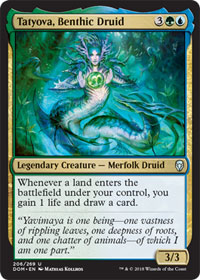
Go big and go home with a victory with the green/blue ramp archetype. While red/green will have incidentally kicked spells, green/blue is the color pair that really lets you build to that late-game power. The most important thing is time, and Green's tokens and Blue's control elements provide you that.
Even if you don't end up with many spells with kicker, green and blue naturally have expensive spells to cast in the late game. Just at common are Cold-Water Snapper, a beefy hexproof threat, and Primordial Wurm, which ties for the third-highest power in the set. That doesn't mean you shouldn't run cheap creatures though. You'll need them to block, and I recommend trading them off as often as possible. If your early combat phases can keep the battlefield clear, your haymakers will have an easier time winning the game later.
If you're building a ramp deck, you'll want seventeen lands. If you have multiple expensive payoffs, or you're splashing another color, you might even want to run eighteen lands. Even if you're ramping your mana, you'll still want to hit all your land drops.
CAUTION: Even in a ramp deck, you're almost never hitting Slinn Voda's kicker cost. Ten mana is more than half the lands in your library. Don't attempt this without Gilded Lotus. (Though, please prove me wrong.)
Making History
Dominaria isn't Time Spiral. We aren't suffering from the mistakes of the plane's past, but letting heroic sagas inspire our futures. Build your deck correctly at this weekend's prerelease and you too can become a revered personality on Dominaria.
As I mentioned before, this set's archetypes aren't very rigid. A loose limited format means it's wide-open for experimentation. In particular, there are a lot of build-around uncommons that can motivate offbeat strategies. Will you build that aggressive green/blue deck with Tetsuko Umezawa, Fugitive and Saproling tokens? Maybe your mana base will be solid enough to incinerate faces with a controlling Darigaaz Reincarnated deck. Keep your mana curves, creature counts, and removal packages in mind and let the legends of Dominaria's past inspire new stories.
I wish you all good luck at your Dominaria prereleases this weekend and any drafts you play after! I hope today's article helped guide your deck building and highlight some neat interactions. You can reach me on Twitter at @_SEV8 for questions or comments or simply share below.
-
View User Profile
-
Send Message
Posted Dec 24, 2020MyBalanceNow
-
View User Profile
-
Send Message
Posted May 23, 2018-
View User Profile
-
Send Message
Posted Apr 17, 2018-
View User Profile
-
Send Message
Posted Apr 17, 2018-
View User Profile
-
Send Message
Posted Apr 17, 2018-
View User Profile
-
Send Message
Posted Apr 16, 2018-
View User Profile
-
Send Message
Posted Apr 19, 2018